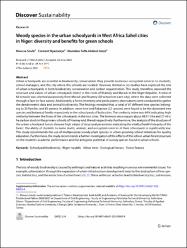| dc.contributor.author | Soulé, Moussa | |
| dc.contributor.author | Nyamekye, Clement | |
| dc.contributor.author | Abdoul‑Azize, Hamidou Tafa | |
| dc.date.accessioned | 2022-08-09T08:31:44Z | |
| dc.date.available | 2022-08-09T08:31:44Z | |
| dc.date.issued | 2022 | en_US |
| dc.identifier.uri | https://doi.org/10.1007/s43621-022-00092-9 | |
| dc.identifier.uri | https://hdl.handle.net/11363/3647 | |
| dc.description.abstract | Urban schoolyards are essential in biodiversity conservation; they provide numerous ecosystem services to students,
school managers, and the city where the schools are located. However, limited or no studies have explored the role
of urban schoolyards in both biodiversity conservation and carbon sequestration. This study, therefore, assessed the
structure and values of urban schoolyards forest in the cities of Niamey and Maradi in the Niger Republic. A total of
60 schools was selected purposively from Maradi and Niamey (30 schools in each city), where the data were collected
through a face-to-face survey. Additionally, a forest inventory and participatory observations were conducted to gather
the dendrometric data and animal biodiversity. The fndings revealed that, a total of 97 diferent tree species belonging to 35 families and 81 genera. In addition, neem tree and Fabaceae (22 species) were found to be the dominant tree
species and botanical family respectively in the schoolyards of both cities. The similarity index was 64% indicating high
similarity between the foras of the schoolyards in the two cities. The biomass value equals about 48.91 t/ha and 27.49 t/
ha carbon stock in the primary schools of Niamey and Maradi respectively. Furthermore, the analysis of the structure of
the urban schoolyard forests showed high values of structural parameters indicating the vitality/health/integrity of the
forest. The ability of students to name plants, animals, and ecosystem services of their schoolyards is signifcantly low.
This study recommends the use of multipurpose woody plant species in urban greening school initiatives for quality
education. Furthermore, the study recommends a further investigation of the efects of the school urban forest structure
on the students’ academic performance and the allergenic potential of woody species found in urban schools | en_US |
| dc.language.iso | eng | en_US |
| dc.rights | info:eu-repo/semantics/openAccess | en_US |
| dc.rights | Attribution-NonCommercial-NoDerivs 3.0 United States | * |
| dc.rights.uri | http://creativecommons.org/licenses/by-nc-nd/3.0/us/ | * |
| dc.subject | Schoolyard biodiversity | en_US |
| dc.subject | Niger republic | en_US |
| dc.subject | Urban trees | en_US |
| dc.subject | Ecological literacy | en_US |
| dc.title | Woody species in the urban schoolyards in West Africa Sahel cities in Niger: diversity and benefits for green schools | en_US |
| dc.type | article | en_US |
| dc.relation.ispartof | Discover Sustainability | en_US |
| dc.department | Uygulamalı Bilimler Yüksekokulu | en_US |
| dc.department | Uygulamalı Bilimler Fakültesi | en_US |
| dc.relation.publicationcategory | Makale - Uluslararası Hakemli Dergi - Kurum Öğretim Elemanı | en_US |
| dc.contributor.institutionauthor | Abdoul‑Azize, Hamidou Tafa | |



















